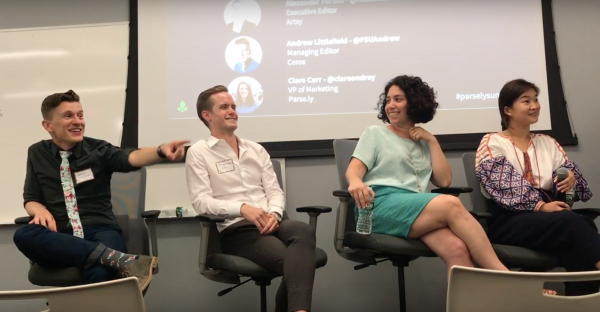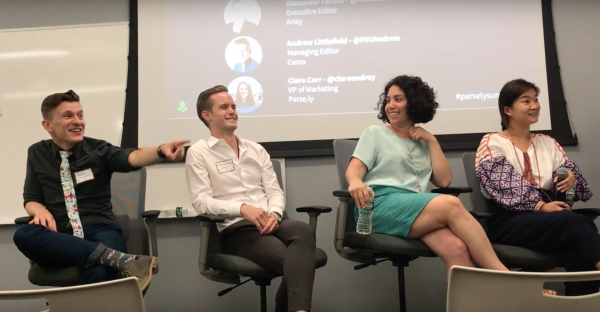Driving conversions and creating brand loyalty at Artsy, domino, CUSTOM and Ceros

Brands and publishers must both navigate questions about changing metrics, platforms, and monetization, complicating the purpose of content. What should each article, newsletter, or post deliver in terms of audience impact? We gathered editorial and analytics leads from four very different outlets—domino, Artsy, Ceros and Digiday’s CUSTOM studio—and asked them how they view the relationship between content and conversions.

Ceros faced a conversion conundrum
Parse.ly research shows that over 52 percent of brands who create content consider conversions the most useful metric, but publishers don’t agree: only 13.3 percent of publishers said they find conversions useful. Is content’s endgame a mere conversion—a purchase, an email sign-up, a membership? Or is it something greater—a larger-than-life brand identity?
Ceros‘ blog went through an evolution process and decided to steer toward the latter. “We went from a B2B software blog, sharing ‘Tips and Tricks’, to a more mature storytelling approach,” Andrew Littlefield, the Managing Editor of Ceros’ blog, said. “In the last 6 months, we’ve expanded to more visual storytelling and becoming a more grown up editorial property.”
“We’re intentionally taking away from that lead generation and content marketing strategy, and doing more of a branding play,” Littlefield said. “We hope people learn about Ceros and what we are as a company, but I don’t want to only be focused on getting people to click on the product page or request a demo. I want us to have some kind of ongoing relationship with people.”

Littlefield said that if their team was solely focused on conversions, they’d reduce themselves to content marketers who produce quick hit stories. But the editorial team at Ceros leverages their sleek, interactive design interface to produce higher quality storytelling that connects emotionally with readers. Looking at the bigger picture may not directly cause readers to take an immediate action; however, the the goal is an engaging brand identity that benefits the company long-term.
Creating an editorial mission for Artsy
Alexander Forbes, the Executive Editor at Artsy, spoke about how brands can drive mindshare by thinking differently than traditional publications. Artsy developed an editorial mission to make art more accessible. To understand if they’ve accomplished that, they look at a range of metrics, including whether people have become excited about art to the point of making a purchase.
Instead of stories that might attract widespread attention, Artsy aims to tell stories to keep a dedicated group of people coming back. “Miley Cyrus was at Art Basel in Miami Beach, and a lot of [art] publishers covered it. But that doesn’t get a lot of people excited about art in the long term,” Forbes said.
“We look at how we can move audiences from a purely educational reading environment, into over time thinking buying is something they want to do. [Direct conversions] are not part of our editorial goals and I don’t think they ever would be. The biggest benefit to the business is really growing mindshare,” Forbes said.
CUSTOM content at Digiday prizes depth over breadth
Digiday’s audience reads about some pretty niche business topics, like header bidding and ad blocking. For brands looking to reach that audience, Deanna Zammit, Executive Producer of Digiday Media’s creative content agency CUSTOM, looks at time-on-page to see if these types of stories are successful. A small number of people need to know about header bidding, but if those people spend four engaged minutes on the brand’s content about it, that’s a huge win for their advertisers.
“We’re able to show our clients, ‘Look, header bidding’ isn’t for everyone, but the people that are into it are really into what we do,’” Zammit said. Zammit said when brands overlook time-on-page, it speaks to an old school digital mentality of looking for impressions and breadth instead of depth.
“With time on page, we use it to justify whether or not we’ve done a good job,” Zammit said. “It’s really as simple as that.”
The merger of commerce and content at domino
domino, the resurrected lifestyle brand that Condé Nast sold in 2009, has the benefit of brand cache and a digital-first mindset. “Digital has become such a great channel for us to hear what our audience is interested in, so we can always make sure our content reflects that. What’s different is that we have a print publication that’s really our best marketing tool,” said Executive Director of Marketing, Growth and Analytics, Tracy Cho.
Since the site offers e-commerce along with content, users spend time on the site researching, reading, and flipping through a catalogue of 14,000 products. Therefore, the time-on-site metric is always fairly high. Instead of prioritizing that metric, as other publishers are doing, domino looks at metrics like: what is the activity a user has taken, and how often do they visit the site?
“We want to see that our users are not only coming to us for a minute or two,” Cho said. “We want to know that you’re coming back to us. That’s how we measure success. If we can capture that mindshare — you’re not coming back to domino one time a month, but you’re coming back to us three times a month, four times a month — it really shows we have an impact on your decision making, your life.”
The common goal of audience engagement, achieved through content, blurs the line between brands and publishers at both ends of the spectrum. Whether you’re a brand or publisher, creating deeply enriching experiences around your content is essential to keep your community of readers coming back.